
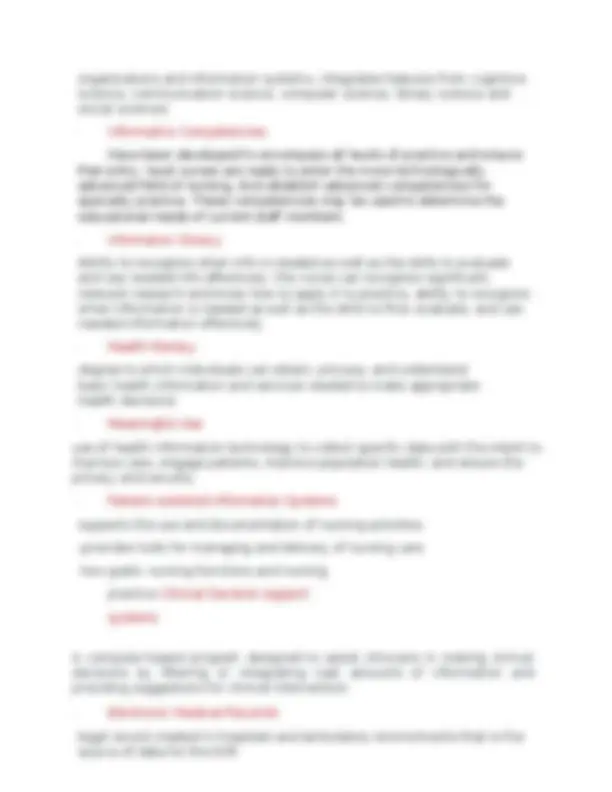

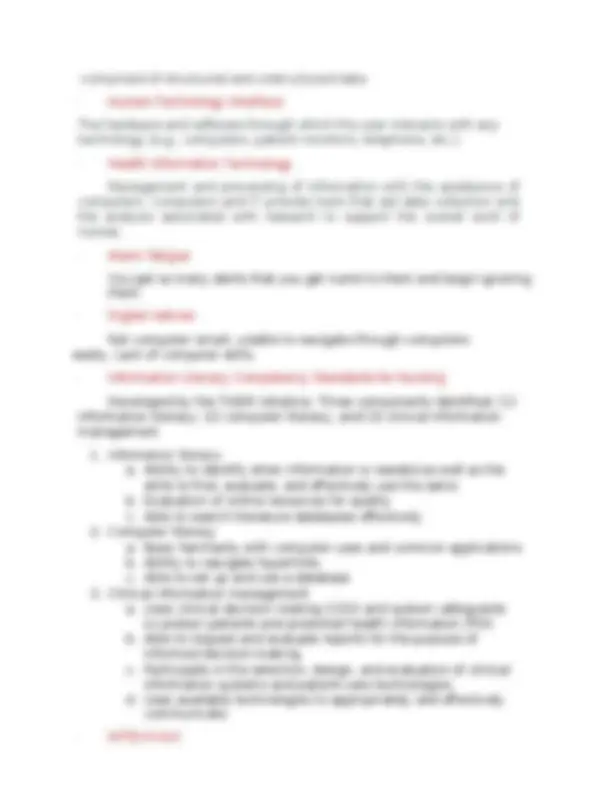

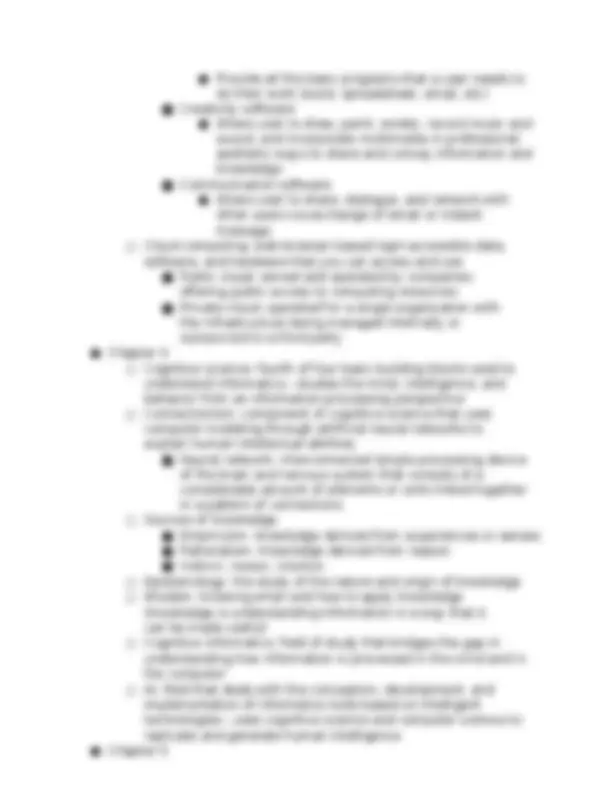
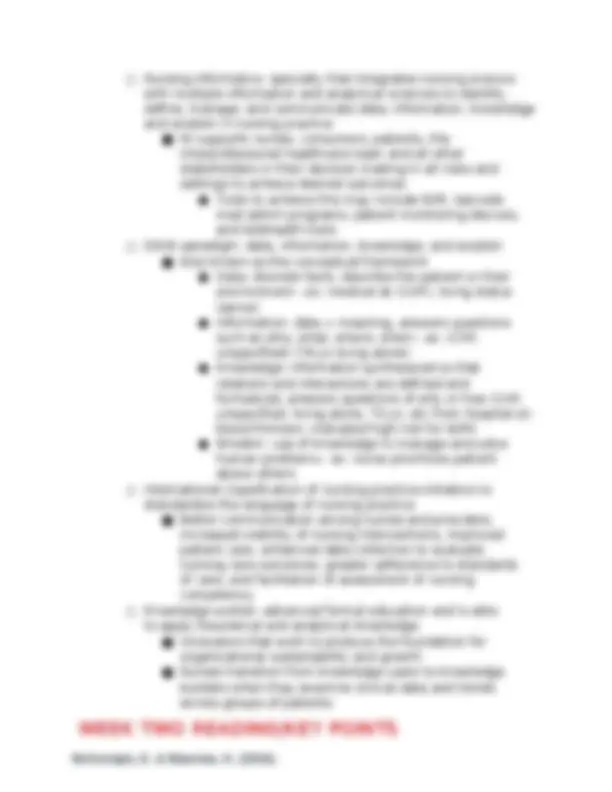
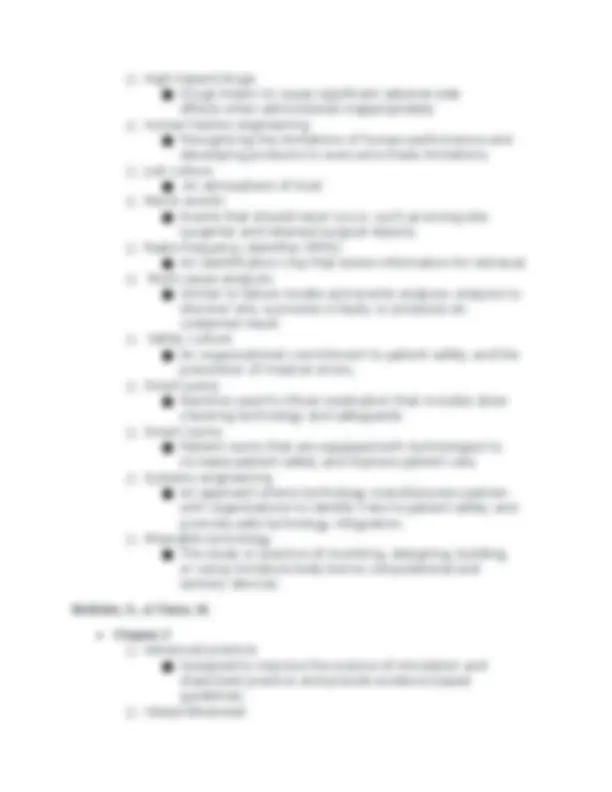
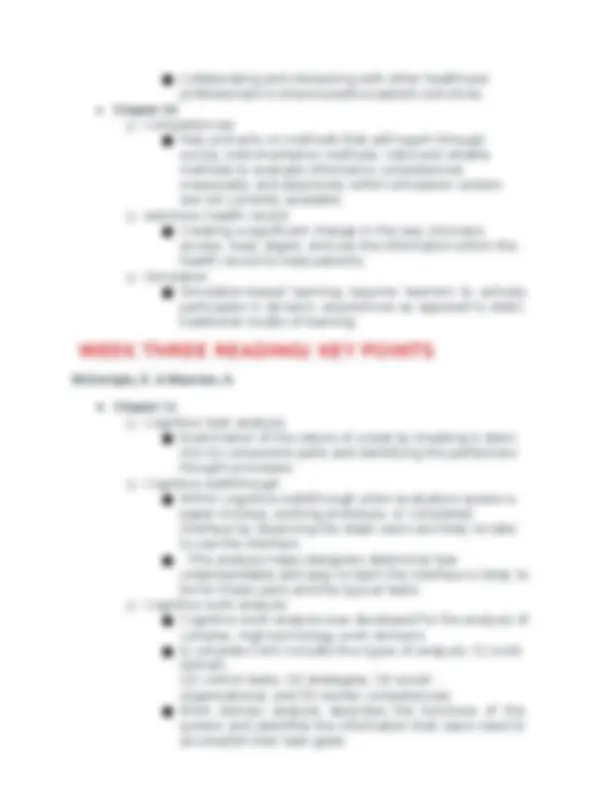
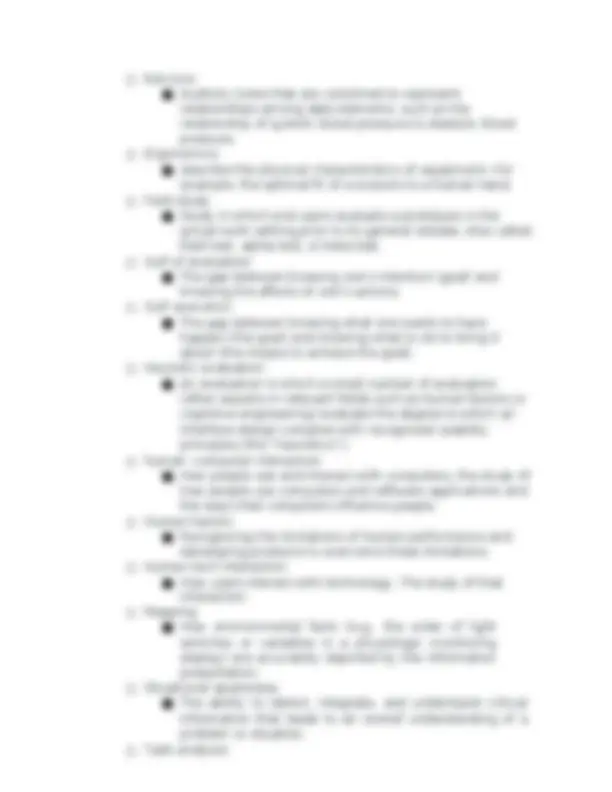
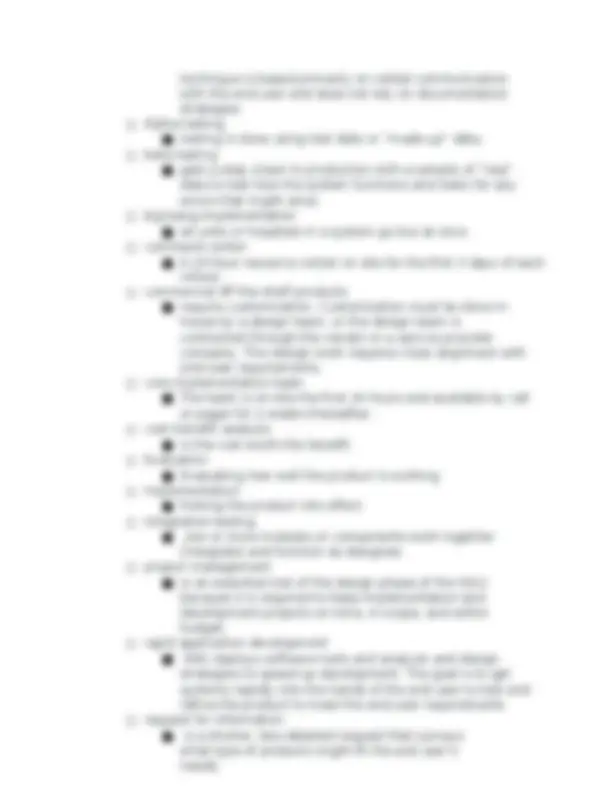



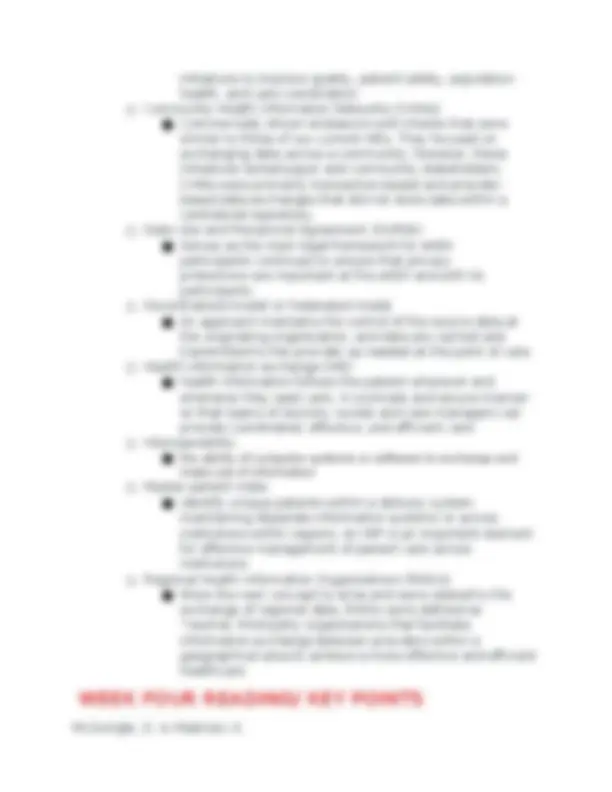
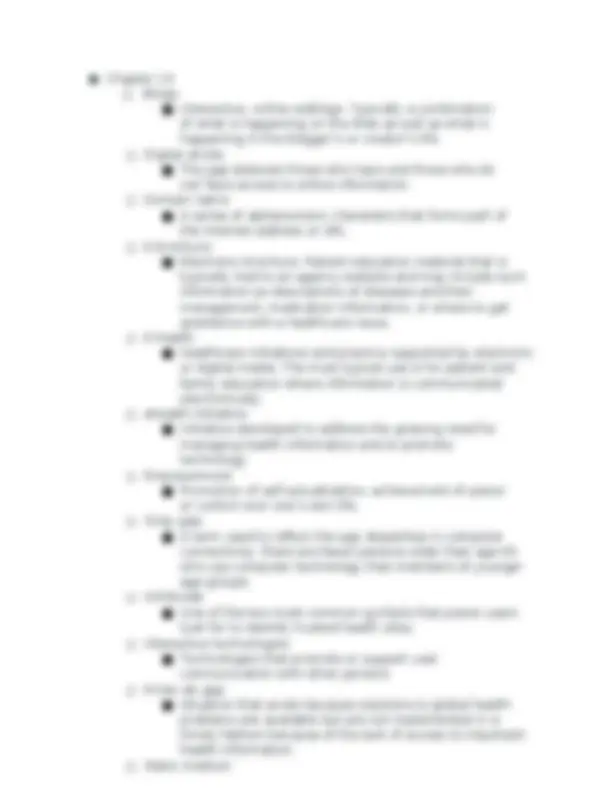
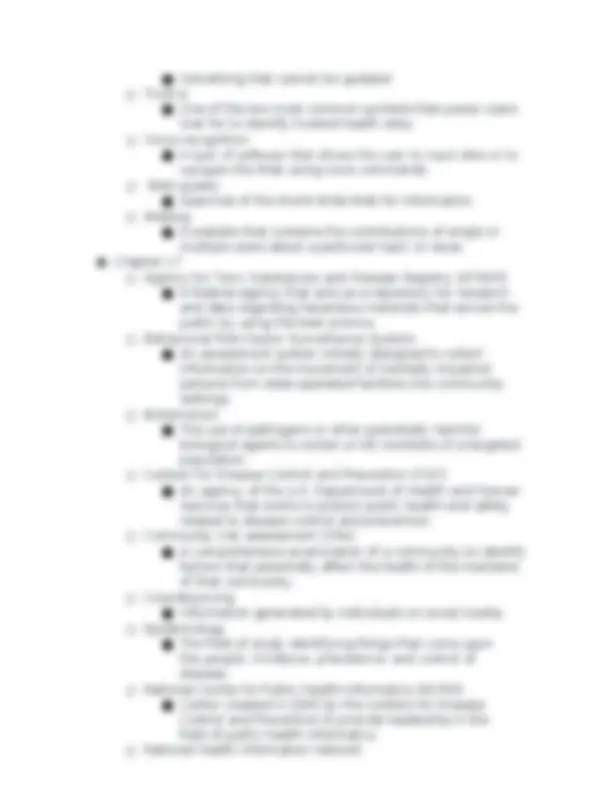
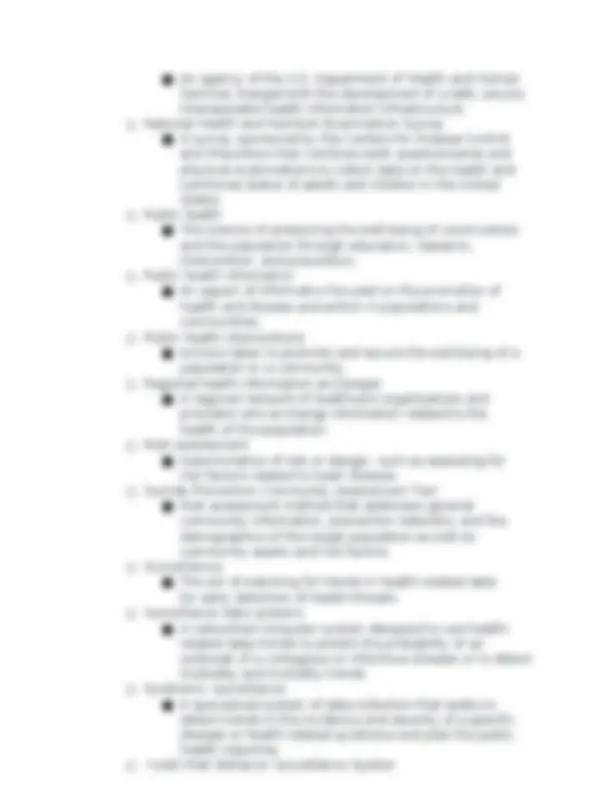
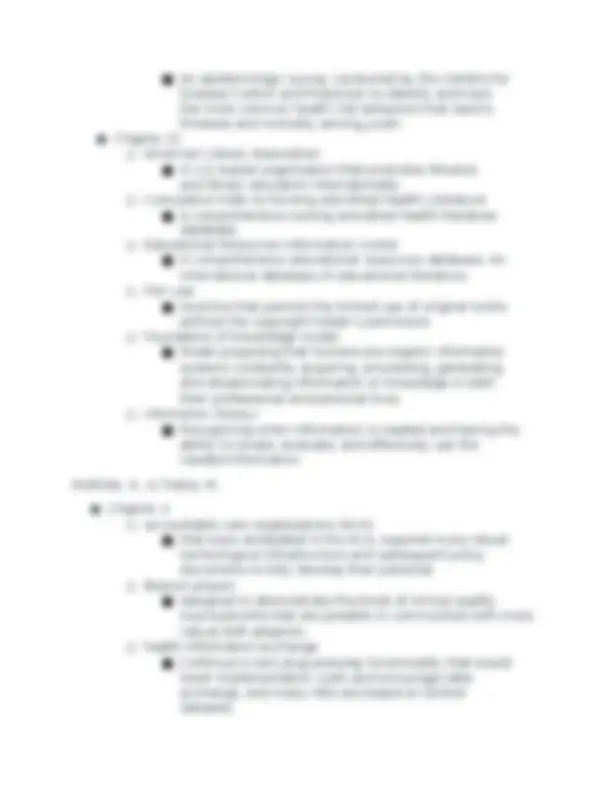
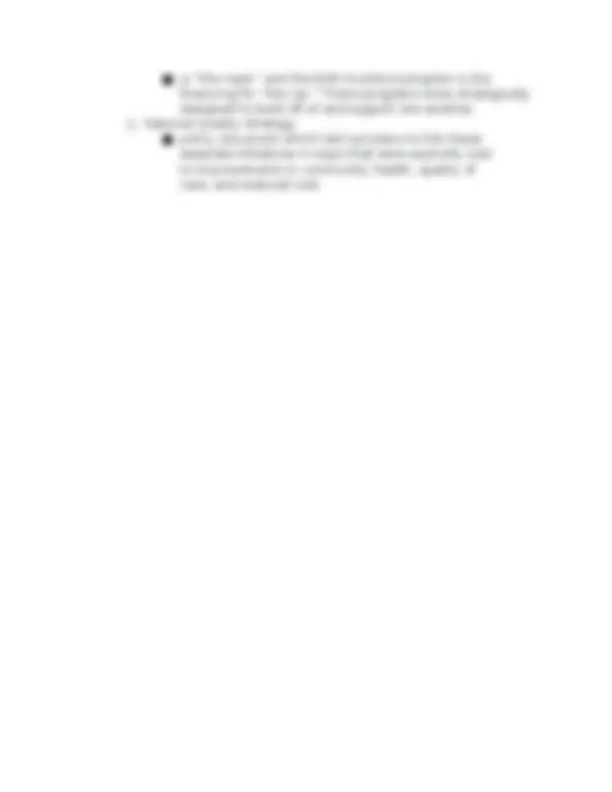


Study with the several resources on Docsity

Earn points by helping other students or get them with a premium plan


Prepare for your exams
Study with the several resources on Docsity

Earn points to download
Earn points by helping other students or get them with a premium plan
Community
Ask the community for help and clear up your study doubts
Discover the best universities in your country according to Docsity users
Free resources
Download our free guides on studying techniques, anxiety management strategies, and thesis advice from Docsity tutors
This study guide provides an in-depth exploration of nursing informatics, a specialty that integrates nursing science, computer science, cognitive science, and information science. The guide covers topics such as data and information management, health literacy, meaningful use, patient-centered information systems, cognitive science, and ai. It also delves into the structure of a computer, software, cloud computing, and cognitive informatics.
Typology: Exams
1 / 27

This page cannot be seen from the preview
Don't miss anything!




















· Midterm Study guide NR 599 Informatics General principles of Nursing Informatics Nursing informatics is the specialty that integrates nursing science with multiple information management and analytical sciences to identify, define, manage, and communicate data, information, knowledge, and wisdom in nursing practice. One of the most frequently quoted and widely accepted definitions of nursing informatics is that it is a combination of nursing science, information science and computer science · Knowledge
process, generate, and dis- seminate nursing knowledge to advance the nursing profession. Knowledge Dissemination: Disturbing and sharing of knowledge learned Knowledge Generation: Creating new knowledge by changing and evolving knowledge based on your experience, education and input from others Knowledge Processing: The activity or process of gathering, collecting or perceiving, analyzing, saving and transmitting knowledge The Foundation of Knowledge model specifically prompts nurses to extend their theoretical and metaphorical knowledge into practical, holistic determinations based on a variety of factors and contexts. Because competencies in informatics include but are not limited to information literacy, computer literacy, and the ability to use strategies and system applications to manage data, knowledge, and information, the ability of nursing students to use computer-mediated communication skills is essential to their success in the nursing field and as a means to improve patient safety.
-long referred to as single episode treatment
-comprised of structured and unstructured data · Human-Technology Interface The hardware and software through which the user interacts with any technology (e.g., computers, patient monitors, telephone, etc.). · Health Information Technology Management and processing of information with the assistance of computers. Computers and IT provide tools that aid data collection and the analysis associated with research to support the overall work of nurses. · Alarm fatigue You get so many alerts that you get numb to them and begin ignoring them · Digital natives Not computer smart, unable to navigate through computers easily. Lack of computer skills. · Information Literacy Competency Standards for Nursing Developed by the TIGER initiative. Three components identified: (1) information literacy, (2) computer literacy, and (3) clinical information management
○ Information science: study of information science-- concerned with input, processing, output, and feedback of data and information through technology integration with a focus on comprehending the perspective of the stakeholders involved and then applying IT as needed. ■ Systemically based-- deals with big picture, opposed to individual pieces of technology ■ Integrates communication science, computer science, cognitive science, library science, and social science ■ Links people and technology ■ Machines (inorganic ISs) Humans (organic ISs) ■ Focuses on why and how technology can be put to best use to serve the information flow within an organization ○ Information systems: handle the needs of the entire organization (communication, tracking, and research) ○ Input: collecting and acquiring raw data ■ Keyboards, touch screen, mice, light pens, automatic scanners ○ Processing: retrieval, analysis, synthesis of data-- transforms data into useful information and outputs ■ Storing for future use, making calculations, comparing data ○ Output: dissemination-- produces helpful information ■ Reports, documents, summaries, alerts, outcomes ● Chapter 3 ○ Motherboard: central nervous system of the computer-- facilitates communication among all components of the computer ○ Hard disk: permanent data storage area that holds gigabytes of data, information, documents even when the computer is turned off. Backing up important files are important because disk drives are not infallible ○ Random-access memory: temporary storage that allows the processor to access program codes and data while working on a task--the contents of RAM are lost once the system is rebooted or shuts off ○ Software: application programs ■ OS software ● Most important software on any computer ● Very first program to load on computer start-up and is fundamental for the operation of all other software and the computer hardware ● Allows user to multitask with ease ● Described in 6 basic processes: Memory, device, processor, and storage management, application and user interface
■ Productivity software
○ Nursing informatics: specialty that integrates nursing science with multiple information and analytical sciences to identify, define, manage, and communicate data, information, knowledge and wisdom in nursing practice ■ NI supports nurses, consumers, patients, the interprofessional healthcare team and all other stakeholders in their decision making in all roles and settings to achieve desired outcomes ● Tools to achieve this may include EHR, barcode med admin programs, patient monitoring devices, and telehealth tools ○ DIKW paradigm: data, information, knowledge, and wisdom ■ Also known as the conceptual framework ● Data: discrete facts, describe the patient or their environment-- ex: medical dx (CHF), living status (alone) ● Information: data + meaning, answers questions such as who, what, where, when-- ex: (CHF, unspecified) (78 yo living alone) ● Knowledge: information synthesized so that relations and interactions are defined and formalized, answers questions of why or how (CHF, unspecified, living alone, 70 yo, d/c from hospital on blood thinners- indicated high risk for ADR) ● Wisdom: use of knowledge to manage and solve human problems-- ex: nurse prioritizes patient above others ○ International classification of nursing practice:initiative to standardize the language of nursing practice ■ Better communication among nurses and providers, increased visibility of nursing interventions, improved patient care, enhanced data collection to evaluate nursing care outcomes, greater adherence to standards of care, and facilitation of assessment of nursing competency ○ Knowledge worker: advanced formal education and is able to apply theoretical and analytical knowledge ■ Innovators that work to produce the foundation for organizational sustainability and growth ■ Nurses transition from knowledge users to knowledge builders when they examine clinical data and trends across groups of patients
McGonigle, D. & Mastrian, K. (2018).
● Chapter 7 ○ Advocate/policy developer ■ A nurse informatics specialist who is key to developing the infrastructure of health policy. Policy development on the local, national, and international levels is an integral part of this role. ○ Certification ■ System for validating that a nurse possesses certain skills and knowledge or is competent to complete a task. Competence and skill level are determined by or based on an external review, assessment, examination, or education. ○ Consultant ■ A person hired to provide expert advice, opinions, and recommendations based on his or her area of expertise. ○ Data ■ Raw facts that lack meaning. ○ Decision support/outcomes manager ■ Person charged with reviewing the effects of interventions suggested by the computerized decision support system. ○ Educator ■ Sage, leader, and/or guide who assists in the process or practice of learning. ○ Entrepreneur ■ Person who assumes the risks of beginning an enterprise or business and accepts responsibility for organizing and managing the organization. ○ Informatics ■ A field that integrates a specialty’s science, computer science, cognitive science, and information science to manage and communicate data, information, knowledge, and wisdom in a specialty’s practice. ○ Informatics innovator ■ One who makes enhancements or improvements and creative, novel, and inventive solutions in the informatics specialty. ○ Informatics nurse specialist ■ A registered nurse with formal, graduate education in the field of informatics or a related field, who is considered a specialist in the field of nursing informatics. ○ Knowledge worker ■ Those who work with information and generate information and knowledge as a product. ○ Medical informatics
○ High-hazard drugs ■ Drugs known to cause significant adverse side effects when administered inappropriately ○ Human factors engineering ■ Recognizing the limitations of human performance and developing products to overcome these limitations. ○ Just culture ■ An atmosphere of trust ○ Never events ■ Events that should never occur, such as wrong-site surgeries and retained surgical objects. ○ Radio frequency identifier (RFID) ■ An identification chip that stores information for retrieval. ○ Root-cause analysis ■ Similar to failure modes and events analysis; analysis to discover why a process is faulty or produces an undesired result. ○ Safety culture ■ An organizational commitment to patient safety and the prevention of medical errors. ○ Smart pump ■ Machine used to infuse medication that includes dose- checking technology and safeguards ○ Smart rooms ■ Patient rooms that are equipped with technologies to increase patient safety and improve patient care. ○ Systems engineering ■ An approach where technology manufacturers partner with organizations to identify risks to patient safety and promote safe technology integration. ○ Wearable technology ■ The study or practice of inventing, designing, building, or using miniature body-borne computational and sensory devices. McBride, S., & Tietze, M. ● Chapter 2 ○ Advanced practice ■ Designed to improve the science of simulation and share best practice and provide evidence based guidelines. ○ Interprofessional
■ Collaborating and interacting with other healthcare professionals to ensure positive patient outcomes. ● Chapter 24 ○ Competencies ■ Rely primarily on methods that self-report through survey instrumentation methods. Valid and reliable methods to evaluate informatics competencies measurably and objectively within simulation centers are not currently available. ○ electronic health record ■ Creating a significant change in the way clinicians access, read, digest, and use the information within the health record to treat patients. ○ Simulation ■ Simulation-based learning requires learners to actively participate in dynamic experiences as opposed to static, traditional modes of learning.
McGonigle, D. & Mastrian, K.
○ Cognitive task analysis ■ Examination of the nature of a task by breaking it down into its component parts and identifying the performers’ thought processes. ○ Cognitive walkthrough ■ Within cognitive walkthrough when evaluators assess a paper mockup, working prototype, or completed interface by observing the steps users are likely to take to use the interface ■. This analysis helps designers determine how understandable and easy to learn the interface is likely to be for these users and the typical tasks ○ Cognitive work analysis ■ Cognitive work analysis was developed for the analysis of complex, high-technology work domains ■ A complete CWA includes five types of analysis: (1) work domain, (2) control tasks, (3) strategies, (4) social– organizational, and (5) worker competencies ■ Work domain analysis describes the functions of the system and identifies the information that users need to accomplish their task goals
■ Analytic technique that focuses on how a task must be accomplished, including detailed descriptions of task- related activities, task characteristics and complexity, and the environmental conditions required for a person to perform a given task. ○ Usability ■ The ease with which people can use an interface to achieve a particular goal. Issues of human performance during computer interactions for specific tasks within a particular context. ○ Workarounds ■ Ways invented by users to bypass the system to accomplish a task; usually indicate a poor fit of the system
■ Computer-based data warehouses or repositories of information regarding the health status of a client, which are replacing the former paper-based medical records; they are the systematic documentation of a client’s health status ○ HITECH ■ Title XIII of the American Recovery and Reinvestment Act, which was enacted in February 2009. Under this act, healthcare organizations can qualify for financial incentives based on the level of meaningful use achieved; the HITECH Act specifically incentivizes health organizations and providers to become “meaningful users.” ○ American Recovery and Reinvestment Act (ARRA) ■ An economic stimulus package enacted in February 2009 that was intended to create jobs and promote investment and consumer spending during the recession. This act has also been referred to as the Stimulus or Recovery Act. There was a push for widespread adoption of health information technology, ○ Meaningful use ■ The American Recovery and Reinvestment Act of 2009 specifies three main components of meaningful use: ● (1) the use of a certified electronic health record (EHR) in a meaningful manner, such as e- prescribing ● (2) the use of certified EHR technology for electronic exchange of health information to improve quality of health care
● (3) the use of certified EHR technology to submit clinical quality and other measures. ○ The criteria for meaningful use will be staged in three steps. ■ Stage 1 (2011–2012) set the baseline for electronic data capture and information sharing. ■ Stage 2 (2013) ■ Stage 3 (expected to be implemented in
● Chapter 1 ○ Health information exchange (HIE) ■ Data translated into actionable information with extensive data management and reporting capability on which providers can manage and improve care ○ Medicare Access and CHIP Reauthorization Act (MACRA) ■ there is significant emphasis on expanding the requirement to capture more structured data, better quality reporting, and better capacity to exchange data using HIEs within and across states and regions ○ Merit-Based Incentive Payment System (MIPS) ■ with a focus on interoperability ○ National Strategy for Quality ■ Improvement in Health Care, several legislative components have been implemented. ○ Patient Protection and Affordable Care Act (ACA) ■ focused on providing all Americans with access to quality and affordable healthcare ○ The third content domain of the NEHI framework: goal to improve patient outcomes ■ Patient safety ■ Population health ■ Quality ● Chapter 8 ○ Agile ■ Agile development is a technique that is a programmer-driven technique that creates a feedback loop with the end users. This
○ request for proposal (RFP)
■ includes detailed specifications and requirements that typically serve as a more binding proposal or offer to accomplish the goals or product needs of the customer ○ return on investment (ROI) ■ electronic information systems and technology in the healthcare setting is an important consideration, but other success factors include improvements in quality, safety, and population health. ○ Scrum ■ is considered by some to be the most popular software development agile framework and is a term used for iteration ○ Sprint ■ is defined by the “scrum master” or the agile team’s facilitator. ○ Superuser ■ Users that have expert technology skills ○ system testing ■ is typically done by the system analyst to make sure the system functions as the designer understood it to be developed. ○ systems development life cycle (SDLC) ■ is a standardized approach used to develop and implement an information technology (IT). ■ This framework is often used across industries to structure best practices for IT development and deployment. ■ SDLC is a phased approach used to analyze and design information systems that is broken into distinct phases ○ unit testing ■ is one specific component or module that performs a specific task ○ Waterfall ■ approach to development occurs in a cascade fashion with analysts and users proceeding in a sequenced manner from one phase to the next. The phases are linear in approach and do not cycle back around to inform the former stage. ● Chapter 11 ○ Business associate agreements (BAA) ■ BAA is in place with each of their partners to maintain security and overall HIPAA compliance. ○ Centralized model ■ HIE data sharing is protected through data-sharing agreements, and data are stored for use by organizations